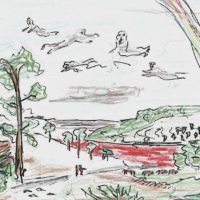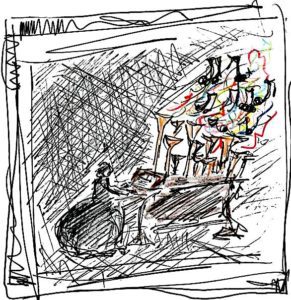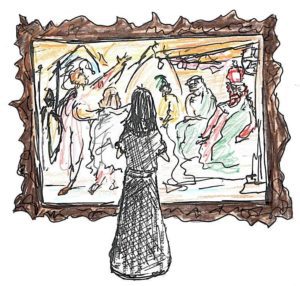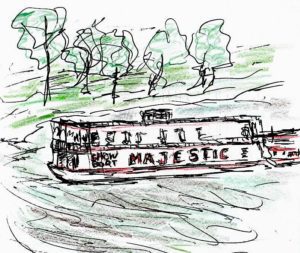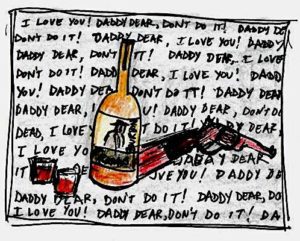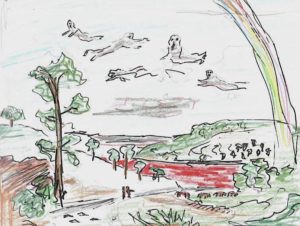“While everything is done that can be conceived of to make you happy, there is a weight pulling at your heartstrings, because you see that other hearts are heavy, and the nobler the heavier.”
—Harriet Martineau, Retrospect of Western Travel
It always starts with a river. Call it Tiber, Mosna, Euphrates, Nile, Mississippi, Yellow, Indus, or what you will. It’s no wonder, then, that George Remus, “King of the Bootleggers,” settled by the Ohio so he might convey Kentucky bourbon to the far-flung and thirsty, bless him. He had a wife, as many men do, and, like a lot of men, he killed her. Some do it metaphorically, some over vast swaths of time—slowly, slowly—and some just pick up a gun and shoot.
Remus was born by the River Lech, a natural border between Bavaria and Swabia, so naturally the Ohio River was déjà vu—a line between those who made contraband and those who bought it. What he failed to reckon was the Ohio’s older, graver partition that in some nostalgic haze he ignored, or at least tried to explain away like the variable morning fog over Lunken Airport, built in 1925 down by the Little Miami, one of the Ohio’s many branches.
Six years prior to Lunken’s first flight, some folks made the apocalyptic conjecture that Americans could live without booze so they passed a law that said so. But whatever lines lawmakers drew between sin and decency were twisted at best, and Remus meant to cross them. In fact, he had the distinct feeling people couldn’t live without booze so he made Cincinnati his base of operations; from here, throw a rock and you’re sure to hit a bottle of whisky. Yes, Remus knew the Ohio was for him. It was biological, coded in Remus’ genetic material: river babies are used to bridges, to crossing back-and-forth, between this and that. It’s a scientific fact: their hearts are flood-prone.
The Ohio made a fine partition: Me ~ You. Us ~ Them. Ohio, after all, comes from the Iroquois word for “good river.” I like the workaday quality of that. Good river. Good enough. A right and proper waterway. My people—mostly English and German, inculcated centuries ago into a religion of whiteness and persistence—never liked their rivers too showy anyway. In Cincinnati, with its valley like the Rhine’s, walls of hills on either side, and a river running through, one persists by remembering what’s been left behind and by striving to remake it: big-wheeled steamboats like water mills; coal on a barge like a body on a pyre. Most settlers found on the Ohio enough metaphoric resonance to satisfy.
The river was my childhood’s backcloth. I felt a rush of light and air as it went up, and when it came down—mud and sewage, mess and muck. “This is a river,” the grownups said, “and you’re a duck, a fish, a beaver!” No, I’d think to myself, I’m just myself. The river was good for storytelling, but was always held at allegorical distance. I couldn’t wait to move away; maybe to an ocean city; maybe someplace colder, where I could stand on a dock in a harbor thick with masts and lobster pots and see to the end of seeing.
Some of my friends stayed in Cincinnati and scored apartments with great views. Good for them. From their windows they saw what they thought was the breadth of the Ohio, but it continues southwesterly from Pennsylvania to Illinois; theirs is just a sliver of the river. To be rich means to hover above it, not to be too near. To be near it is to go crazy. It’s to always see the other side.
But “crazy” is a capricious, ugly word. Let’s just say that river babies have a propensity for self-loathing. Along Eastern Avenue, headed west mornings to school, I’d see, painted on the sides of buildings: giant flood markers, houses with what looked like dirty skirts, poverty, and how the two form a dialectic. We called flood-zoners “river rats,” another way to say “poor white migrants,” from places like West Virginia, Eastern Kentucky—hardly far on the larger map—but far enough to muddy the border between what we see and what we think we know. Once in a while, I’d come across a little weedy plot, maybe a patch of gravel right at the water’s edge, and wonder how I could get this close to the Ohio—the second-dirtiest river in the U.S.—a borderline whose symbol obscures the thing it is: a trap, a mirage, a trompe l’oeil.
After riding a paddle steamer called the Henry Clay in 1835, English essayist Harriet Martineau wrote:
The shores of the Ohio are so beautiful, that I could not bear to lose a single glimpse between [emphasis mine] the hills…There were the children running among the gigantic trees on the bank, to see the boat pass; the girl with her milk-pail, half-way up the hill…
“Betweenness” means not only to be in the gut, but, by extension, to be eaten by the river’s gall and poison. It means to disintegrate as much as it means to blossom.
Martineau was born on the River Wensum so prone to digression, and, like me, had a winding, wandering pace, but the Ohio’s torrent in this so-called “New World” appealed to her quicker appetites. Here, she claims to have seen nature’s pulsing, palpable growth, almost sexual in its rapacious stirring of silt, erosion and bursting seeds, cicadas rupturing out of dirt. In a state of awe, Martineau saw the Ohio’s indifferent course, then proposed a theory: a worker may know only his singular gesture, and a consumer may know only the product she purchases, but nature doesn’t know, nor care, nor purchase. The mountain, the river—same as the crow, the beaver—work toward an architecture none of us will live to see finished. And so,
it’s a matter of practice. Martineau’s voluminous output isn’t the point but, rather, the writing itself, the thinking through, the endless essaying. Maybe that’s why, when Martineau disembarked in Cincinnati, she could be seen leaning scandalously close to millionaire Nicholas Longworth’s art collection, appraising each brush stroke with great scrutiny. Benjamin West’s Hamlet: Act IV, Scene V, Ophelia and Laertes, a massive 1792 painting left a particular impression. She called it a “preposterous picture”… “the sight of which amazed me after all I had heard of it.”
The painting’s focal point is Ophelia in a gauzy, white gown, her white hair disheveled and wet against her cheek. Martineau found West’s scene ridiculous in its pretension of madness—a madness Martineau took for disorderly love. This is, after all, the selfsame woman who dismissed Charlotte Brontë for what she saw as Brontë’s unhealthy preoccupation with love. It was, I hear, Villette that tore that particular friendship apart.
Martineau herself was called “unwomanly” for her intellectualism—a blessing and a curse—earning her both public praise and condemnation, like the storm over the Ohio that she witnessed whose lighting sent “one splendid violet-coloured shaft…straight down into the forest.” It awed her when, from the deck of a paddle steamer, she saw “a tall tree first blaze and then smolder at the touch. A noble horse floated by, dead and swollen.”
So, when she stood in Longworth’s parlor with a cluster of Cincinnati socialites, Martineau gasped in delight and horror at West’s canvas, and heard in the deepest dark spirals of her ear a buzzing. A bird thrumming its wings. A junebug. Wind through a transom. She looked up and saw, surprised, that the river isn’t even in the painting,
though it seemed to her to be everywhere.
Sun on the water, blue drift. Capt. Tom Jefferson Reynolds had a daughter named Catherine who played the calliope to signal the boat’s coming—an ugly sound generally, but to the people who recognized and welcomed it, tender and true, steam forced through a valve, keys made of metal. The boat brought a show to the people: a hodgepodge of melodrama and vaudeville—a little Shakespeare, a dollop of Yiddish theatre, a dog act, a singing child or two, inter-stitched, a little grimy, monologists and song-and-dance men, a contamination of pure forms, a mélange, a tripe, a trot, a thrill, a gasp. Jefferson’s first boat caught fire and burned up his firstborn son. The second he called America, and the third he named for the feeling he got early in the morning when out on the river nothing was wrong, yellow jackets landing on a wood pile, thunder in the last town, clear skies in the next—the sort of sound that rises from the sternum and sails out through the top of the head. Call it the calliope or what you will; Cat was at it. Awe. Ah. Call it The Majestic.
“My Old Kentucky Home”
“The Blue Alsatian Mountains”
“Home Sweet Home”—
No, never play that one. If you do, your boat will sink. The Water Queen did. 1936 on an iced-over Kanawha River. But leave it to “Crazy” Ray Choissier to dive into the wreck two years later, or, at least, to wade in, and with a jacked-up rig of joints and pulleys, raise the calliope from its grave. “Take me out to the ball game! Take me out to the crowd!” He babied that poor drowned thing, restored her, brought her back to fighting weight. Then Commodore E. J. Quimby went to see Ray in Connecticut and with some finagling, got him to sell the calliope—only by promising it would see regular action aboard a steamer, given a purpose again, given a reason to blow her whistles. Quimby wanted to make the showboat show again, to lift its gloom and so, “Thence to Waterbury to see a man about a Calliope.”
Out of Cincinnati—a good and proper river baby—Thomas J. Nichol was the country’s foremost calliope-maker— who believed copper pipes made for a “sweeter sound.” E. J. Quimby:
Slim has one Steam Calliope that he wants to keep and operate. The other one (less boiler) is a genuine Thomas J. Nichol job, with sweet-toned copper whistles and he will consider selling it to us. It is the Calliope from a very famous Ohio River Showboat named the WATER QUEEN, which sank in the mouth of the Kanawha River during the 1936 ice-jam. L. Ray Choissier (“Crazy Ray”) was her famous Calliopist and it was he who returned to the scene in 1938 and salvaged this instrument from the sunken WATER QUEEN. It has 32 whistles and balanced valves. The keyboard is new, having been installed by Slim Somers (from a Hammond Organ). These rare whistles are the chief asset. Bottom C is about 6” in diameter, -not puny like the air jobs.
Cat on the steam keys, Tommy the advance man, brim over his eyes, tacked notices to telephone poles, bus depots, the insides of women’s thighs. And like the tinkling spray of chimes from ice cream trucks, youth heard calliope music and the river carried that raucous mess of liquid theatre closer, inch by inch, fathom by fathom.
The showboat docked anywhere a captain could pull up, his children spilling out from the cabin fore and aft, so many of them it was downright Biblical, all of them, in their way, exhibitionists, and even the children that weren’t his own—so many, he admitted, he couldn’t keep track—appeared to share his attributes: hawkish eyes, beak-like nose. He was a modest man except for his living, but then again, what’s a river good for? He could pilot a barge heavy with coal. He could, with a team of burly longshoremen, load and unload pork, or he could fish and sell his catch down on Race Street.
Really, he would’ve preferred to map the Ohio back in its unmapped days, but he was born too late so, what to do but carry a particular brand of American culture to the sorts of people who’d pay him in chickens. Cat would be a payday if she could really sing and whether any burlesque girl was passing as white, how should he know? Mind your own business. His first allegiance was to the river, second to show. If a child was born to him, he’d create a budding talent, stick them in, and, if not, they’d learn to tie a knot, to swab and polish and oil. He used a tugboat called Attaboy to pull his girl, and this tug held the mess, the sleeping quarters for his inner fold, an engine as pugilistic as a bulldog , which ultimately would kill him, backfiring as he was trying to fix the damn thing, scaring him shitless, plunging him back into the river he was born to.
The city of Cincinnati bought The Majestic after it passed between a few college theatre groups over the years, then docked it permanently, minus the Attaboy, on the riverfront where a parade of regional performers undertook a kind of rehabilitation project, that is, to return The Majestic to its afore-mentioned, glorious sleaze. Lo, how they’d slip between cabins barefoot where the Ohio and the Allegheny met.
I saw A Chorus Line at The Majestic. A girl I went to high school with—a dancer—got a good part. We thought she had “made it”—to get a summer job at The Majestic was even better than King’s Island, the local amusement park, since the boat had nearly a century’s worth of show biz under its proverbial belt, a history, as it were, whose imminence gilded the air. The boat’s use had tipped over into something like that of a museum object, since every show bore the weight of its ancestral vaudeville, its racial animus, its weird confluence of home and show and boat. A Chorus Line too is a show about shows with characters based on their original performers. In other words, a confluence. No one is exactly who they claim to be. The strictures of class and gender deteriorate like ice on the river come spring. A showboat is a bit of a queer place and A Chorus Line is a queer show: an older dancer searches for a new chance. Younger dancers exude an old-person sadness. Entertainers of all body types, all sexual proclivities. And my friend from high school had that scrawny, scrappy Appalachian-made look about her. She stuffed her bra and sang the “Dance 10, Looks 3” number in her not-so-good dancer’s voice, and we applauded like crazy because—wow—what a perfect song for her, the same girl who told us she did the splits during sex and was, I heard, seduced by the choir director. In any case, I looked up at her on The Majestic’s stage and thought her stunningly beautiful. I was in awe. A tiny little thing in her tights and crop top. “Tits and ass can change your life / They sure changed mine!”
I sometimes sit in front of Hamlet: Act IV, Scene V, Ophelia and Laertes, feeling a little ashamed. Quiet at first: like good friends, we sit together.
The trick to vanishing, I find, is to focus my attention on some small facet of the canvas—one day Ophelia’s hair, the next day Claudius’ crown—and resituate myself inside it, or, even better, travel with my eyes to the far background where, lost in a haze of indeterminate landscape, lays the river Ophelia drowns in. Indeterminacy is, I believe, a symptom of Ohio Valley fever. This is such a pathetic little river in a pathetic country, I think to myself, and yet it means, to the overall composition, so much: a silvery-gray-blue-brown tear-duct, the Mason-Dixon, a carotid artery.
I suppose the sublime can’t happen by a river as prosaic as the Ohio, but sublime is the way I feel driving from the Cincinnati Art Museum, down the hill, through Eden Park, the city splendid below me, and the river—but for lights along its banks, and the lights of boats and barges on its water—so dark it could be a length of hair. I should probably tell you: the road is called Elsinore and at the foot of it are crenelated grey towers—remnants of a grand park entrance with its flight of stairs Cincinnatians once climbed as if on pilgrimage up, up, up to Eden glittering like a diadem on the brow of the hill. Hair and crown and river.
***
George Remus killed his wife Imogene in Eden Park. They drove in separate cars to sign divorce papers, making of themselves a two-person funeral procession. Their route took them from Quebec Road in Price Hill to Westwood Avenue to Vine Street to East Liberty Street to Gilbert Avenue, up into Eden where, in October, the oak groves had begun to blush a deep red, their dropped leaves like the blood orange rinds Imogene had sucked and thrown down laughing onto their breakfast table years ago. Her appetite had always been happy and loud.
The cars never once lost sight of each other despite merging traffic, and it was only when Imogene’s driver slowed to yield that George happened to glance up and see her stumbling out of her Rolls’ opened door, breaking into a run—gawky because of her black hobble skirt—toward the park’s Gazebo at Mirror Lake. The next thing George knew he was chasing her, pistol in hand.
A recent New York Post article reports Imogene screamed as he pressed his pistol to her gut, “Daddy dear, I love you! Daddy dear, don’t do it!”
It was her name for him: Daddy. And “Morally Justifiable Homicide” was the phrase Remus used to justify her murder—that, and “insanity.” Insanity, he supposed, was easy enough to prove or disprove, thanks to its elliptical nature. In 1927 the U.S. legal system had yet to import and effectively integrate Freud’s hypotheses about human psychology, so, for Remus’ sake, insanity retained its distinct otherness—a state of being quite apart from a person’s normative personality—as if a person could be momentarily extracted from their body and the spirit of—say—Zeus put in its place, that raging patriarch who more than anything enjoyed assuming an animal’s shape—a swan, for example, skimming the limpid shallows of a river for a body to hover over.
What a murderous love affair.
I sometimes try to imagine Imogene’s final thoughts:
Sometimes in my dreams I talk to him. I could say that there’s no war coming and certainly no good reason for one, that God is just an old friend with bad breath, that we all touch ourselves sometimes, and that shame should be reserved for the profiteers. Sometimes in my dreams we go walking through Queensgate down by the river—all abandoned warehouses from the bad old hog-slaughtering days—and we talk about what we want from the world and he’d say, jokester that he is, “Trotters and snouts!” and I’d say, “Loin!” and he’d say, “Shoulder!” and we’d laugh and laugh until we fall down on our backs like animals in a fable, laughing so hard we can’t stop, then we hold each other tight and cry some more from laughing because he says, “I’m gonna shoot,” and I think he means a picture, a film, something, anything other than a gun, but later I come to find out he’s got one. “See that ‘No Swimming’ sign?” I say and point to the river, “Let’s go swimming.”
Imogene found Remus in a Chicago deli; it was corned beef he liked, with a dill pickle. She wore her hair back in a net, but it shone like a silver dollar in a fist. He found her irresistible. “The market’s a dirigible,” he told her. “It rises and sinks, rises and sinks, spasmodically. At this moment it’s rising; god forbid it should fall, but if it does, the Ohio River will soften her.” Later, vomit of champagne and oysters on the front steps of their Price Hill mansion caused revelers to slip and tumble drunk into the swimming pool. The story goes, Remus’ parties are what Fitzgerald modeled Gatsby’s after
and, as in Gatsby, Remus could gaze from one bank of the river to the next and see green, green, green.
Oh well, we used to say. At least we don’t live in Kentucky. Kentucky belongs to Daisy Buchanan, if you catch my drift. For Kentucky, we reserve our finest disdain. Kentucky’s the sort of state that stews in its own juice. It once bore a syndicate and to enforce it, had the nerve to invent the Tommy gun. It housed whores and gamblers and loose women generally, folks said, the state set aside by Ohio’s native people for hunting—a “dark and bloody land,” they called it. The enslaved crossed the river to be rid of it. Foals born to it were broken at two, run to death by five. To us, it was the state across the river, not much different from the state we lived in, only “the land of tomorrow,” meaning, I suppose, land below this land, progress having made it an extension of Cincinnati’s neighborhoods sprinkled like ellipses over hills linked now and then by bridges and ferries when, long ago, people breached the border furtively by raft or skiff, under night’s cover, under cover of darkness.
You can only call it “bourbon” if it comes from Kentucky.
Today, I’m at a liquor store, running my eyes along a line of whisky bottles, and there it is: Remus Bourbon, George’s solid, stolid German face slapped on the label beside a QR code I immediately scan with my phone. “Part Hero. Part Villain. All Legend,” the website reads, and, “Some rules were made to be broken. Prohibition for example.” Funny how some things get painted over, if not plain forgotten.
Naturally, I think of my dad—a bourbon-fan and honorary Kentucky colonel (for lives he saved as a doctor)—so I text him. He’s since moved away. I ask if he ever drank Remus Bourbon. “No,” he writes, “who’s Remus?” I ask him if he ever swam in the Ohio. “Once, off a boat,” he says, “and that’s it.” I swear I remember him telling me he played in it all the time as a kid. In fact, I can picture him with a swollen toddler’s belly, water like sloe gin behind him, his body in silhouette. It’s the golden hour and he’s wading through it. All is wicked in the world. Years are drowned like a sack-full of kittens, and the river’s just a gurgle in the throat, a body choked by cattail, sweet flag, and slurry.
***
“Cincinnati is chockfull of ghosts,” my niece tells me. She’s young and her father’s past seems haunted. All Ohio River babies, after all, somehow breathe in Histoplasma Capsulatum and the resulting sickness is what they call Ohio Valley fever, manifesting on X-ray as dark stains dappling the lungs. “What is that?” a doctor from, say, Boston might ask. He’s performing a physical on my sister who’s moved to the East Coast for a job. “What is that?” He calls our father, and tells him, “Your daughter has spots on her lungs.”
“Look at her chart,” our father says. “Look and see where she’s from.”
Now, I don’t use the word “ghosts” lightly, but bear with me; the river is a repository for all types, a downward-moving fugue subsuming all comers. “I suppose Cincinnati is in the Midwest,” Cincinnati-born journalist Jane Coaston says, “but it’s a very southern kind of Midwest, different from, say, Cleveland or Detroit.” The Ohio begins where the Allegheny and Monongahela meet, in what’s now called Pennsylvania, and it ends in what’s now called Cairo, Illinois, where a decidedly Midwestern state meets Missouri, a decidedly Southern one. But these sorts of regional nuances are below the Ohio’s paygrade, having slept in its own stateless bed for ages. After all, its name comes from the Iroquois who themselves migrated from somewhere else. What the Ohio was called before “Ohio,” I couldn’t say,
except that in 1851, another, better river was all the rage. The Hudson Valley School dominated America’s arts scene then, but Robert Duncanson—biracial grandson of enslaved Virginians—loved the Ohio River Valley best and decided to paint it. His murals line the entry to the Longworth house (which would become the Taft house, then, finally, the Taft Museum in Cincinnati). The murals are considered among the finest Antebellum America had to offer. Duncanson immerses us in an earthly paradise of vaster proportions, the human figure reduced in size to barely recognizable thumbprints—allusions to pioneers, explorers, the kinds of people (if people are in the scene at all) who drive the mythos of discovery, then settlement. Some critics think Duncanson was painting his way to justice, and some say he was just another landscape painter helping to secure an ugly American mythos. But I think Duncanson’s particular conflict is rich and beautiful, known and unknown by him, conscious and unconscious. Sometimes the knowing can’t be seen. But sometimes it’s in the dark umber, lamp black, shadows painted on the water, water painted on sap, where vision goes to die, where hill meets hill, a slender brushstroke to imply erasure.
His 1859 Landscape with Rainbow, was chosen as Biden’s inaugural painting, and subsequently hung in the Capital. In it, a white couple walks a country path by a river, probably somewhere near Cincinnati, art historians say. Though we like to think this is the Ohio, it’s not—at least not practically—but only a gesture toward what we want the Ohio to be: great as the Volga, timeless as the Seine, but wilder, uniquely American, blessed by a rainbow which, I have to stress, requires both rain and sun. But the real Ohio isn’t any of those, just a “good river,” I guess, as the Iroquois said. And what it was called before that—
At the Cincinnati History Museum, my interviewer doesn’t even ask me to perform a monologue; he just says I have the job if I want it. He seems exhausted. He tells me I’ll wear period clothes and hang out in the Public Landing exhibit, talking to guests and answering questions. “It isn’t so much an acting job,” he says, “as it is a kind of window dressing.”
The Public Landing is a recreation of a mid-nineteenth century Cincinnati street. There’s a halved paddlewheel steamship called Queen of the West docked at a pretend wharf on a clear resin Ohio “river,” and from the “river,” if you head north up the cobblestone avenue, you’ll find the “evening air” filled with chirrups and hoofbeats, and “gaslights” flickering under the halogen-lit ceiling. You’d see a row of fake businesses—a printing press, a saloon, a millinery shop, a shipping storefront. A high school friend is stationed in the printing office and I’m in the millinery. And we each have a co-worker/acting partner: for me, an unpaid volunteer and for my friend at the printing press, a serious Civil War reenactor who, every hour on the hour, strolls into the millinery, tips his hat, and say, “Ladies,” to which we pretend to be surprised and flattered.
This reenactor dresses in Union blue, goes to Gettysburg every year, and pretends to get killed in trying to pretend-kill pretend-Confederate soldiers. I learn some reenactors treat war like a hobby and some are deadly serious, starving themselves, never bathing, shoving their blistered feet into wool socks, eating biscuits soaked in urine and salted pork cured for years under somebody’s porch. This man at the printing press, he’s that kind.
We’re like animals in some kind of history experiment. Every day I come in and put on my corset and pantaloons and shift and hoop skirt and bodice, my hair up in a snood. I walk down a hallway, and push open a door. It’s so dark. Then my eyes adjust and I hear the sound of bugs and birds and wheels in ruts and steamship whistles and the river gurgling and peoples’ heels tap-tapping. I hear the looped soundtrack of a bunch of men lifting bales and barrels, grunts and shouts.
The woman I work with at the millinery—who I’ll call Mrs. Grose—says, “Good afternoon,” and I say, “Good afternoon.”
Then the guests come. “They’re nothing but hungry little ghosts,” Mrs. Grose tells me. She presses period coins into their palms and shows them what she’s been working on—red, white, and blue trim for a July 4th straw bonnet. A boy looks at Mrs. Grose’s hat and says, “That’s the stupidest thing I ever saw,” and Mrs. Grose tells him to, “Go home and have your mama smack some sense into you.” Everyone in the school group laughs. And the boy holds up a penny his mother gives him for flattening in one of those machines that stamps a picture into the copper. “Who’s that on your coin,” Mrs. Grose asks him.
I have five, maybe ten, minutes with a guest, so I pack in as much as I can. But I’m so shy, and also a little cruel. I want to tell them, did you know that in the 1850s, Cincinnati was known as “Porkopolis” and the Ohio River ran red with pigs’ blood? Also, in a few short years, boys like you would be drafted to serve in the army and would probably meet their doom on the battlefield or by tuberculous? And girls like you would have to wear heavy black dresses and long veils for at least a year if not longer after boys like him were killed, and the dye used for those dresses and veils sometimes contained arsenic, so you were literally and figuratively being poisoned to death?
But I keep all that wickedness to myself. I write my character’s backstory and keep that to myself too. And, over time, the story begins to reshape my character, carving away at her, smoothing her down, even while I’m sleeping, in those moments when no one, not even I am watching. Actors call it “process.” Writers call it “prewriting,” breathing selfhood into a self that doesn’t exist.
I don’t know much about Imogene before she married George Remus, so it’s easy enough to imagine he invented her too, making her up for the benefit of his own legacy. Yes, he made her in the way people are made here—out of a few, torn theatrical notices pasted together to make a whole. It’s as if he were writing his own vaudeville tragedy: a deli clerk becomes a legal secretary, a legal secretary becomes a gangster’s queen, and when, in the final act, he shoots her, the queen becomes a ghost. C’est la vie.
There are, as my niece says, so many ghosts in Cincinnati; they initiate the weather, evaporating only to rain down again, flooding the Ohio, and when the water finally recedes, what do we find? Soggy tires, rusted cans of off-brand beans, a deer skull, one sole-less Nike. Nobody wants these things.
Not so on other, grander rivers. Professional scavengers in England—called “mudlarks”—scour the Thames River’s mudflats each day at low tide. Sometimes they’ll find a Tudor shoe, an imperial coin, a bullet casing, and when they do, they bag it, take it home, and add to their collections, because, like a calliope, these are the things people want from a river. These are valuable things. But if an artifact is too valuable, too important, too rich for a mudlark’s blood, she surrenders it to Her Majesty, the Queen, and the mudlark flies back to where she came from, as poor as she was at the beginning.
***
Rumpus original art by Peter Witte
